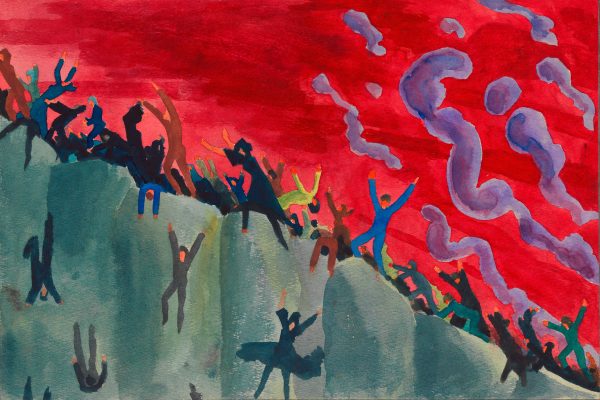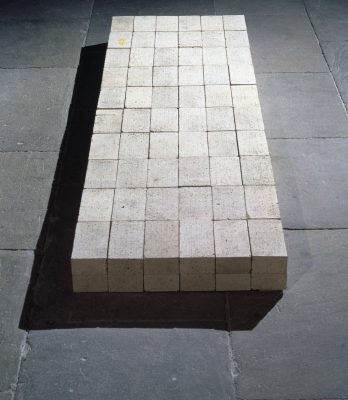Due to our destructive behaviour, writer E.O. Wilson foresaw humanity soon entering the Eremocene – the ‘Age of Loneliness’. This fresh hell would be plagued by an environment void of the many forms of life we see and take for granted today, and, for us humans, result in existential and material isolation. Perhaps it already feels this way. Maybe we’ve discreetly slipped into the Eremocene without much fanfare. It does seem sadly fitting that Wilson passed away at the end of 2021, a year overshadowed by isolation, and that we seem to be burning our way closer to a fully realised Age of Loneliness. Also fitting is the appearance of Missouri Williams’s debut novel The Doloriad; a nihilistic fictional diorama into which she places her characters and watches them suffer.
The Doloriad opens with a palpable sense of dread and a shimmering blackness in the language. (The first chapter is appropriately titled ‘Prolegomena to Future Agonies’.) Dolores, who is mute and has no legs, is stuffed in a wheelbarrow and pushed into the forest by her uncle, who is also her father. She is soon abandoned as a marriage offering to a potential group of distant humans on the horizon. If this feels too grim from the get-go, it’s not, because Williams is an intelligent stylist, deftly unfolding energetic prose reliant on her powerfully strange imagery: ‘Their uncle shuffled along with his unwieldy burden and the cracked lenses of his glasses repelled the sun; the light bounced away from him, splintering into new delusions, and those bright disks, fixed to the head and the long, dry stick of his body, gave him the appearance of a watchtower on the move.’ It’s gorgeous stuff, weird and dark, more Thomas Bernhard and Deafheaven than Chuck Palahniuk and Korn.
The bulk of the novel concerns a massive inbred family overseen by the Matriarch soon after a cataclysmic event that has left the world barren, except for a few birds, insects, a poisoned river and the ‘unbearable whiteness of the new chemical sky’. There’s Jan, Agathe, Marta, Mary, Adam, Jakub, legless Dolores (characters are routinely described by their deformities and physical shortcomings, often lacking limbs and wheelchair bound), and countless other children who inhabit an encampment with crumbling buildings – the Matriarch spends most of her time in one of these buildings, watching the family from a dirty window – and the nearby forest from which Dolores soon drags herself back. Her return sets off a period of reflection, in which the family spend time tangling and untangling their psychic mess, trying to find meaning in their future now that the Matriarch’s plan to offer up Dolores for marriage has failed.
They routinely watch and reenact the only remaining television show on VHS tapes, Get Aquinas in Here, in which the thirteenth-century Italian philosopher comments, sit-com style, on different humorously appalling situations. This subplot is initially introduced as the family’s sole source of entertainment, when not attacking each other, and is later surreally woven into the story as the novel progresses. Mostly, we’re left watching family interactions and beautifully rendered set-pieces as everyone struggles in their lonely state, remembering little of the past and with no imagined future to offer comfort – unless you’re the schoolmaster, who has his ‘mound’, an incredibly haunting visual of a towering structure made of rotting cloth and golden moths. The schoolmaster believes that by physically entering the mound, he will discover salvation by becoming part of something else, a new world. This never comes to fruition, and the schoolmaster’s arc is arguably the most interesting and unique in the novel, a strange balance of creepiness and loneliness.
Dolores is on the end of many mental and physical attacks, and abuse and violence are scattered liberally throughout The Doloriad. But while there’s a gleeful cruelty to Williams’s treatment of her characters, she is not capricious – violence is a necessity born from the environment she has masterfully created – and sympathy is not always absent from her nihilistic world. I found myself moved by the controlling Matriarch when her children turn on her while she is giving a speech, thus obliterating her grip on the family and dissolving her dream for their future. ‘The children hadn’t understood her’, Williams writes. ‘They stared at the crumpled figure in the electric wheelchair and wondered where their mother had gone. Was it a test? Was she punishing them? It was too much; her authority dripped away.’
For the most part, Williams is her own writer, but her influences are visible. A Beckettian undertone runs throughout, not in the traditional sense that life is absurd and full of suffering, but in the sense that there is no god to help alleviate this absurdity and suffering, no matter how strong the desire is for that god to exist. The opening to the second chapter, ‘Today the world was weaker: a milky sun hung in the sky and wanted nothing to do with the earth’, echoes Beckett’s opening to Murphy (1938): ‘The sun shone, having no alternative, on the nothing new.’ The schoolmaster and his wavering devotion to his surrounding books – Augustine, Anselm, and of course, Aquinas – suffer the brunt of the realisation that there is no saviour, after his belief in the mound weakens. In a section focused on the uncle, who I found myself wanting more of, rather than the mass of children who at times blur into each other, Williams writes: ‘The imperfection all around him – it was true that the Creator was gone.’ And, in a stunning and crushing scene on the loneliness of the Matriarch and her brother: ‘instead he placed all his faith in her wrongness and his silent god, who he saw at last was not there and might never have been.’
Toward the end of the novel, the brutality and gore increase, life for the family and the schoolmaster become even weirder after the death of a sibling, and the much abused Dolores finally has her moment. Once discarded in the forest for her physical and mental weakness, she finds herself, for the first time, in total control over her brother Jan, her biggest tormenter, upon whom she exacts revenge. This is satisfying but also terrifying because Dolores, who is perhaps the book’s most sympathetic character, is capable of the same cruelty wielded by everyone around her.
By the end of The Doloriad, I was left not so much with the feeling of exhaustion you might expect from such a heavy work, but with one of awe. The creation may be dark, but the time spent in Williams’s Eremocene is exhilarating, if lonely.




